Introduction to Paddle Boarding
Welcome to the wonderful world of paddle boarding!
If you’re a beginner, you’ve just taken your first stroke into a thrilling and rewarding adventure. Paddle boarding, also known as SUP (Stand Up Paddle), is not only a fantastic way to explore the water, but it’s also a phenomenal workout that engages your entire body.
Plus, it’s a sport that’s growing in popularity faster than you can say “SUP”!
Did you know that paddle boarding is one of the fastest-growing water sports worldwide? According to the Outdoor Foundation, participation in stand-up paddle boarding has seen a remarkable increase, with over 3.5 million people in the United States alone hopping on a board in recent years.
And it’s not hard to see why! It’s easy to learn, offers a great way to enjoy nature, and can be as relaxing or as challenging as you want it to be.
As your paddle board teacher, I’m here to guide you through every step of your SUP journey. From picking out your very first paddle board to mastering your stroke technique, I’ll be sharing tips, tricks, and a few personal anecdotes to make your learning experience as smooth as a calm lake.
So, grab your paddle, put on your sense of adventure, and let’s dive into the basics of how to use a paddle board!
So if you feel more than ready to glide across serene lakes, explore coastal waters, or even try your hand at SUP yoga, this guide will equip you with everything you need to know to get started.
By the end of this article, you’ll be standing tall on your paddle board, like a champ’, ready to take on the water with confidence.
Types of Paddle Boards: Choosing Your First SUP
Now that you’re all pumped up about starting your paddle boarding journey, let’s talk about an important first step: choosing the right paddle board.
With so many options out there, it can be a bit overwhelming, but don’t worry! I’ve got you covered.
We’ll break down the different types of paddle boards and help you find the perfect fit for your first SUP adventure.
Different Types of Paddle Boards
So, you’re ready to get your first SUP. Awesome! But where to start?
There are a few types of paddle boards you should know about. Each one has its own strengths.
- First, there’s the all-around paddle board. This is perfect for beginners. It’s stable, versatile, and works well in most water conditions. Think of it as the jack-of-all-trades in the paddle board world.
- Next up is the touring paddle board. If you’re planning on long-distance paddling, this one’s for you. It’s designed to cut through the water smoothly and quickly. Great for exploring!
- Then there’s the inflatable paddle board. These are super convenient. You can deflate them for easy storage and transport. Don’t worry, they’re very durable and almost as sturdy as hard boards.
- Finally, there are surf paddle boards. These are shorter and more maneuverable, ideal for catching waves with an inflatable sup. If you’re a thrill-seeker, this might be your go-to, especially if you follow the beginners guide.
How to Select the Right Paddle Board for Beginners
Choosing your first paddle board can feel overwhelming. But don’t fret! Here are some tips to help you decide.
- Consider your weight and height. The bigger you are, the bigger your board should be. Always use a size that fits you well. A wider board offers more stability.
- Think about where you’ll paddle. For calm lakes or slow-moving rivers, an all-around board is great. For choppy waters or waves, a surf paddle board might be better.
- Portability matters. If you don’t have a lot of storage space or need to travel with your board, an inflatable paddle board is a smart choice.
- Set a budget. Boards come in a wide range of prices. You don’t need the most expensive board or an inflatable sup to get started. Look for quality and durability.
Essential Features to Look for in a Beginner Paddle Board
When shopping for your first paddle board, keep an eye out for these features:
- Stability: Wider and longer boards are more stable, which is key for beginners.
- Durability: Look for high-quality materials. You want a board that can withstand bumps and scrapes.
- Weight: Make sure you can carry your board comfortably. Some boards are lighter than others.
- Traction pad: This is the area where you stand. It should be comfortable and provide good grip.
- Fin setup: Most boards have fins that help with stability and tracking. Beginners should look for boards with removable or adjustable fins.
By considering these factors, you’ll be well on your way to choosing the perfect paddle board for your first SUP adventure and ensuring the nose of your board cuts through the water efficiently.
If you still not sure which board to pick, you can check out 2 of my articles that will be of interest for you as a beginner : What Size Stand Up Paddle Board Do I Need, full of information on how to choose the best board for you.
And you will love my selection of The B offers various insights including how to stand up on a paddle and more.est Paddle Board for Beginners here.
Preparing for Your First SUP Outing With Your Stand Up Paddle Board

Alright, you’ve picked out your paddle board. High five! Now let’s get you ready for your first SUP outing. This part is all about gearing up and making sure you have everything you need for a fantastic and safe experience on the water.
Essential Paddle Board Gear
First things first, let’s talk gear. Here’s a checklist of what you’ll need:
- Paddle Board: Obviously! Make sure it’s the one you picked out, suited to your weight and paddling style. If you are not sure which one is suitable for you, check this out : What Size Stand Up Paddle Board Do I Need
- SUP Paddle: You can’t paddle without a paddle, right? Adjustable paddles are great for beginners because you can tweak the length until it feels just right. Here is a pick of the best options out there.
- Leash: This is a must for safety. It keeps you connected to your board, so if you fall off, you won’t lose it. Plus, it’s great peace of mind. If you don’t have one, you really must get your leash now, before you go on the water.
- Personal Flotation Device (PFD): Safety first! Many places require you to wear a PFD. It’s a good habit, even if it’s not mandatory.
- Dry Bag: Handy for keeping your phone, keys, and snacks dry. Because soggy snacks are no fun.
Safety Equipment and Why It’s Important : My Best Tips For Your First Sup Journey
I can’t stress enough how important safety is. Paddle boarding is tons of fun, but we need to be smart about it.
- PFD: As mentioned, always wear a personal flotation device. Using a leash is like a seatbelt for the water.
- Whistle: Sounds funny, but a whistle can be crucial in getting attention if you need help. Clip it to your PFD.
- Sun Protection: Wear sunscreen, a hat, and sunglasses. The sun’s rays reflect off the water and can burn you quicker than you think.
- Hydration: Bring water. Paddle boarding can be a workout, and you’ll want to stay hydrated.
How to Dress for Paddle Boarding
Now, let’s talk fashion. No, not really, but what you wear matters.
- Swimwear: If it’s warm, a swimsuit or board shorts are perfect.
- Rash Guard: These are great for protecting your skin from the sun and avoiding any board rash.
- Wetsuit/Drysuit: If the water is cold, you’ll want a wetsuit or drysuit to keep warm.
- Footwear: Barefoot is common, but if you prefer, water shoes or booties can provide extra grip and protection.
Final Check Before You Hit the Water
Before you dash off to your first SUP adventure, do a quick gear check:
- Is your leash securely attached?
- Do you have your PFD and whistle?
- Are all your valuables in a dry bag?
- Did you apply sunscreen?
With all your gear set and safety precautions in place, you’re ready to embark on your paddle boarding journey. Get ready for some fun on the water, and remember, the more prepared you are, the more enjoyable your experience will be.
Launch and Stand: Getting Started on Your Paddle Board
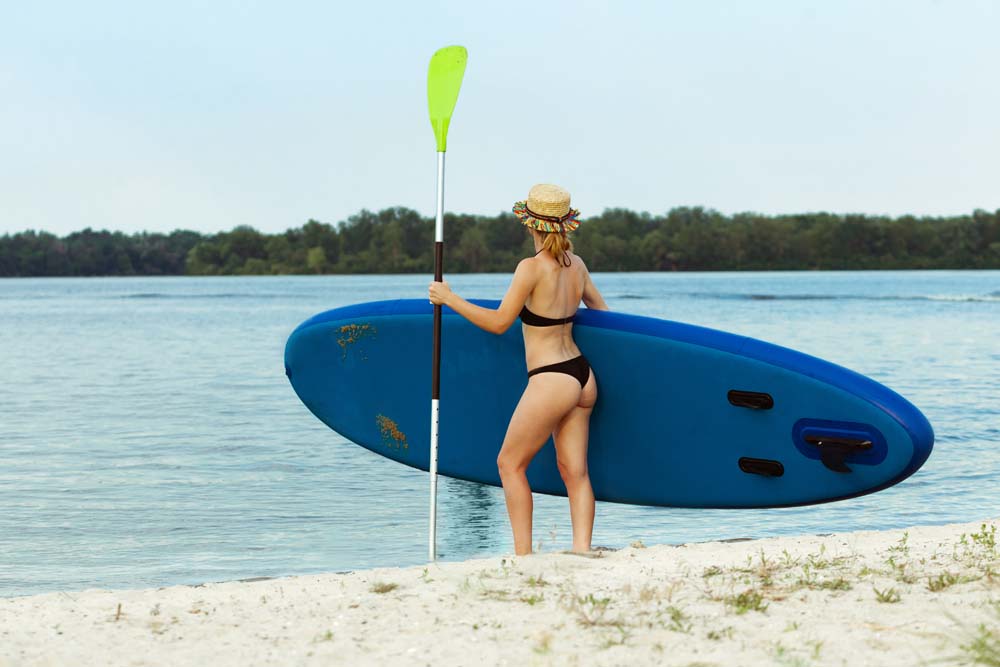
Alright, gear up!
Now comes the exciting part: getting on the water.
Let’s talk about launching your paddle board and standing up for the first time.
Trust me, it’s easier than you think.
And even if you wobble a bit, it’s all part of the fun!
Finding the Right Spot to Launch
Choosing the perfect spot to launch is key. Look for a calm, shallow area without too much boat traffic.
A sandy beach or a gently sloping shoreline is ideal.
Avoid rocky areas at first—your feet will thank you!
If you are not sure how to get to your starting point with your board, read this article : How To Transport Your Paddle Board On a Roof Rack and More.
Step-by-Step Guide to Launching Your Paddle Board
Checking the Wind Direction
Before you even set foot in the water, take a moment to check the wind direction. Wind can be your friend or your foe, depending on how you handle it. Stand facing the water and feel where the wind is coming from. If it’s strong, try to launch from a spot where you’ll be sheltered from the wind, like behind a point or the side of your board near a dock. This makes getting started much easier and keeps you from being blown off course.
Carry Your Board on the Right Side
When you’re carrying your paddle board, it’s crucial to hold it on the right side of your body. Here’s why: if the wind catches your board, it can act like a sail and pull you off balance or drag you away. By keeping the board on the windward side (the side the wind is coming from), you can use your body as a buffer to control the board more easily. Plus, it helps prevent any unexpected flights across the beach!
Here’s how to make a smooth start:
- Carry Your Board to the Water (always check the wind) direction: With your board under one arm and paddle in the other hand, head to the water. If it’s an inflatable, it’s even easier to carry!
- Place Your Board in the Water: Set it down gently, fin-side down. Make sure it’s floating nicely before you hop on.
- Kneel First: Start by kneeling in the middle of the board. This gives you more stability as you get used to the feel of the water beneath you.
- Paddle a Bit on Your Knees: Take a few strokes while kneeling to get the hang of balancing and moving the board.
Tips to Stand Up on a SUP Paddle for the First Time
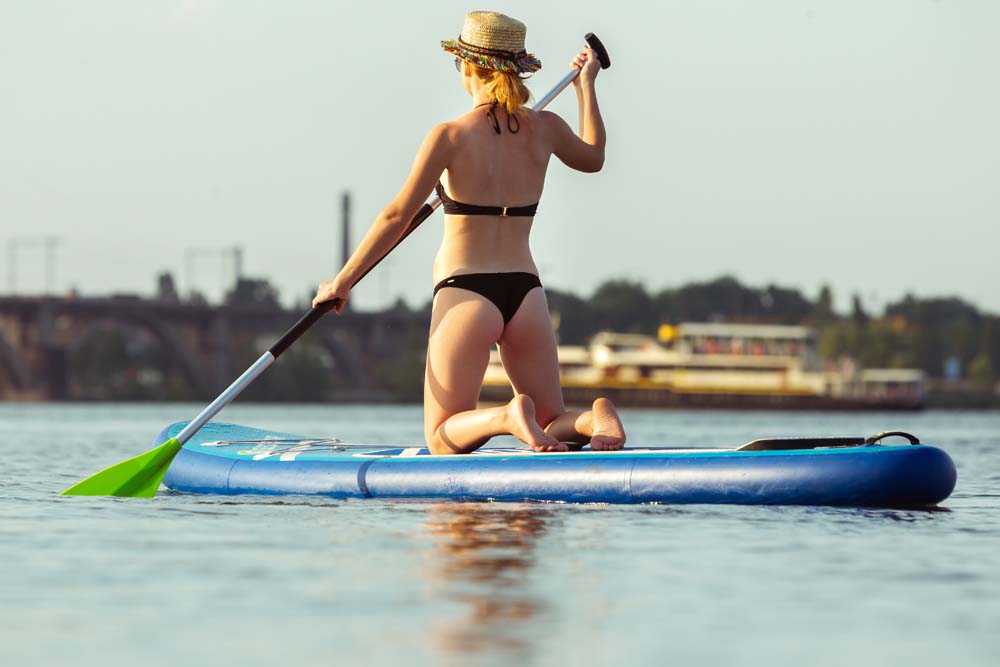
Ready to stand? Here we go!
- Position Your Paddle: Lay your paddle across the board in front of you, perpendicular to it. This gives you something to hold onto as you stand.
- Plant Your Feet: Place your feet where your knees were. Centered and about hip-width apart.
- Stand Up Slowly: Use the paddle for support and stand up one foot at a time. Keep your knees slightly bent and your core engaged.
- Find Your Balance: Look straight ahead, not down at your feet. This helps with balance. Trust your body and the board.
- Start Paddling: Once you’re standing on your paddleboard, grab your paddle and start with gentle strokes. Keep your strokes smooth and even on both sides.
Wobble and Fall: It’s All Part of the Fun
Don’t worry if you wobble or even take a dip in the water. It happens to everyone! The important thing is to laugh it off and get back on your board. Paddle boarding is all about enjoying the moment and embracing the experience, no matter how wet you get.
Remember, practice makes perfect. The more you practice standing and paddling, the more confident you’ll become. And soon, you’ll be gliding across the water like a pro.
Ready for the next adventure? Let’s dive into mastering the basic paddle techniques.
Basic SUP Paddle Techniques: Mastering the Stroke
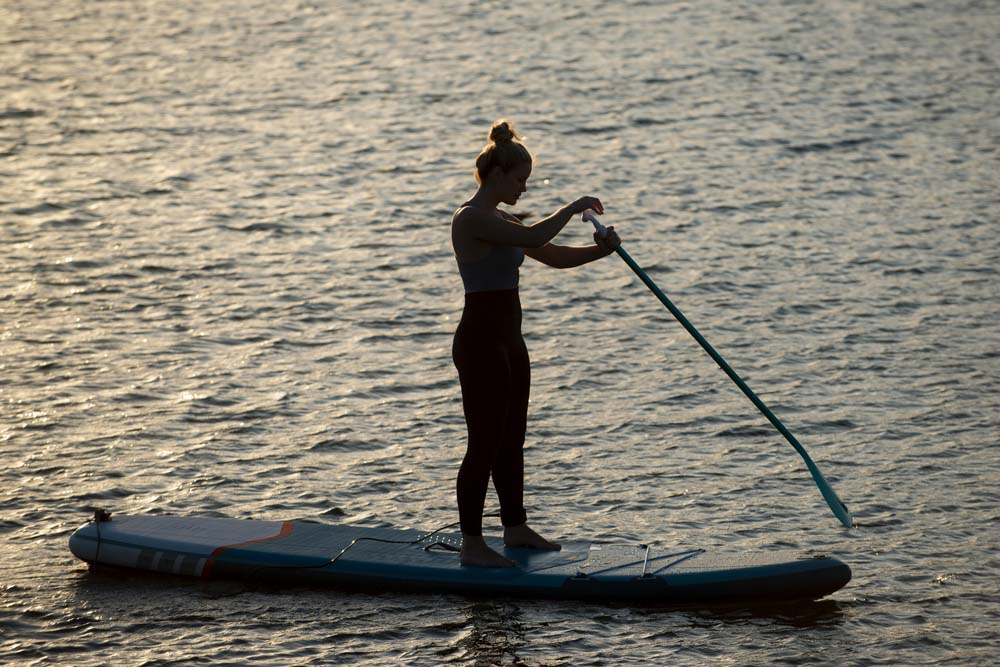
Alright, you’re standing tall on your paddle board and feeling pretty good about it.
Now, let’s focus on paddling.
Getting your paddle stroke right, rather than pulling awkwardly, will make a big difference in how smoothly and efficiently you move on the water. Plus, it’s a great workout!
How to Hold Your SUP Paddle
First things first, let’s talk about how to hold your paddle and the correct hand positions.
- Grip: Your top hand should grip the T-bar handle, and your bottom hand should be about halfway down the paddle shaft. Imagine you’re holding a broom—same idea!
- Paddle Blade: The blade should angle away from you, towards the front of the board. This might feel counterintuitive at first, but it’s designed to give you more power and efficiency with each stroke.
Basic Paddle Strokes for Beginners
Let’s stand up on a paddleboard and get paddling! Here are the fundamental strokes you need to know:
- Forward Stroke: This is your go-to stroke for moving forward.
- Reach forward with your paddle, arms straight and twist, plant the blade fully in the water, and pull it back towards your feet.
- Keep your strokes smooth and even on both sides to maintain a straight line.
- Reverse Stroke: Use this stroke to slow down or stop.
- Plant the blade in the water near your feet and push it forward, towards the nose of the board.
- This stroke is also useful for backing up.
- Sweep Stroke: Perfect for turning your board.
- To turn right, plant your paddle on the left side of the board and sweep it in a wide arc from the nose to the tail. To turn left, do the opposite.
Techniques to Improve Your Paddling Efficiency
To make the most of your time on the water, here are some tips to paddle more efficiently:
- Engage Your Core: Use your core muscles rather than just your arms. This gives you more power and prevents fatigue.
- Keep Your Arms Straight: Bend at the hips and use your whole upper body to paddle. Your arms should stay relatively straight.
- Rotate Your Torso: As you paddle, rotate your torso to increase the reach and power of each stroke. Think of it as a gentle twist with each stroke.
- Smooth Strokes can be achieved by correctly managing your paddle grip.: Aim for smooth, steady strokes rather than choppy, quick ones. This helps you glide more efficiently and maintain balance.
- Practice Makes Perfect: The more you practice, the better you’ll get. Try different strokes and techniques to see what feels most comfortable and effective for you.
By mastering these basic strokes and techniques, you’ll be able to navigate the water with ease and confidence. Paddle boarding is not just about standing on the board—it’s about moving gracefully and efficiently across the water.
Ready for more? Let’s dive into some additional tips and tricks to enhance your paddle boarding skills!
Paddle Boarding Tips for Beginners
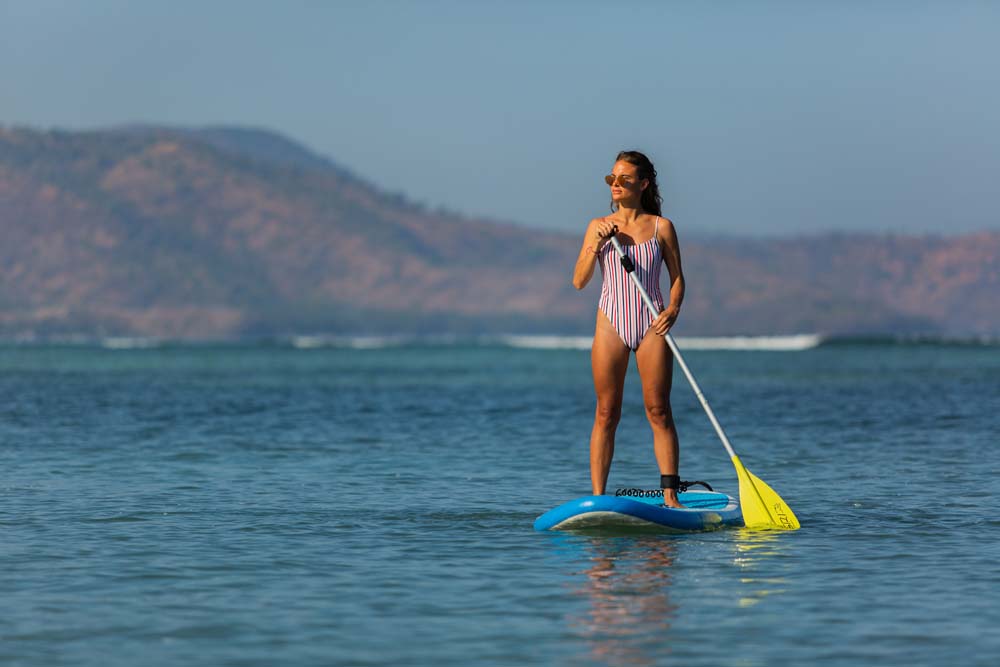
You’re getting the hang of paddling, and now it’s time to take your skills to the next level with some handy tips.
These pointers will help you stay balanced, navigate different water conditions, and avoid common beginner mistakes. Let’s dive in!
Balancing and Stability Tips
Staying balanced on your paddle board is all about positioning and practice. Here are a few tips to keep you steady:
- Keep Your Knees Slightly Bent: This helps absorb any wobbling and keeps you more stable.
- Stay Low: When you feel unstable, lower your center of gravity by crouching down a bit. This can help regain your balance.
- Look Ahead: Keep your eyes on the horizon rather than looking down at your feet on the center of the board. This helps with balance and direction.
- Use Your Paddle for Balance: If you start to wobble, place your paddle in the water. It acts like a third leg, helping you stabilize.
Navigating Small Waves and Currents
Encountering waves and currents can be a bit intimidating at first, but with the right techniques, you’ll glide through them like a pro.
- Face the Waves: When you see a wave coming, face it head-on. This reduces the chance of tipping over.
- Paddle Strong: Keep paddling with strong, steady strokes. Momentum helps you stay balanced on your paddleboard.
- Go With the Flow: In currents, let the water help guide you. Adjust your paddling to work with the current rather than against it.
- Stay Relaxed: Tension can lead to more wobbling. Stay loose and let your body move naturally with the board.
How to Avoid Common Beginner Mistakes
Even seasoned paddle boarders had to start somewhere. Here are some common beginner mistakes and how to avoid them:
- Standing Too Far Back or Forward: Find the sweet spot in the middle of the board. Standing too far back can make the nose lift, while too far forward can submerge it.
- Holding the Paddle Incorrectly: Remember, the blade should angle away from you. Check your grip often.
- Paddling Only on One Side: This can cause you to go in circles. Alternate sides to keep a straight path.
- Not Using Your Core: Relying only on your arms can be tiring. Engage your core for more power and less fatigue.
- Ignoring Safety Gear: Always wear your leash and PFD. They’re not just for beginners—they’re essential for everyone’s safety. If you are looking for the perfect leash, check this out The Best Paddle Board Leash here.
Staying Confident and Enjoying the Ride
Lastly, the best tip of all: have fun! Paddle boarding is a fantastic way to enjoy the outdoors, get some exercise, and explore new places.
Stay confident, keep practicing, and enjoy every moment on the water. Mistakes and wobbles are just part of the journey, and every outing is a step towards becoming a more skilled paddler.
With these tips in mind, you’re well on your way to becoming a proficient paddle boarder.
Next, let’s explore some advanced techniques and tips for your first SUP outing!
Advanced Tips for Your First SUP Outing
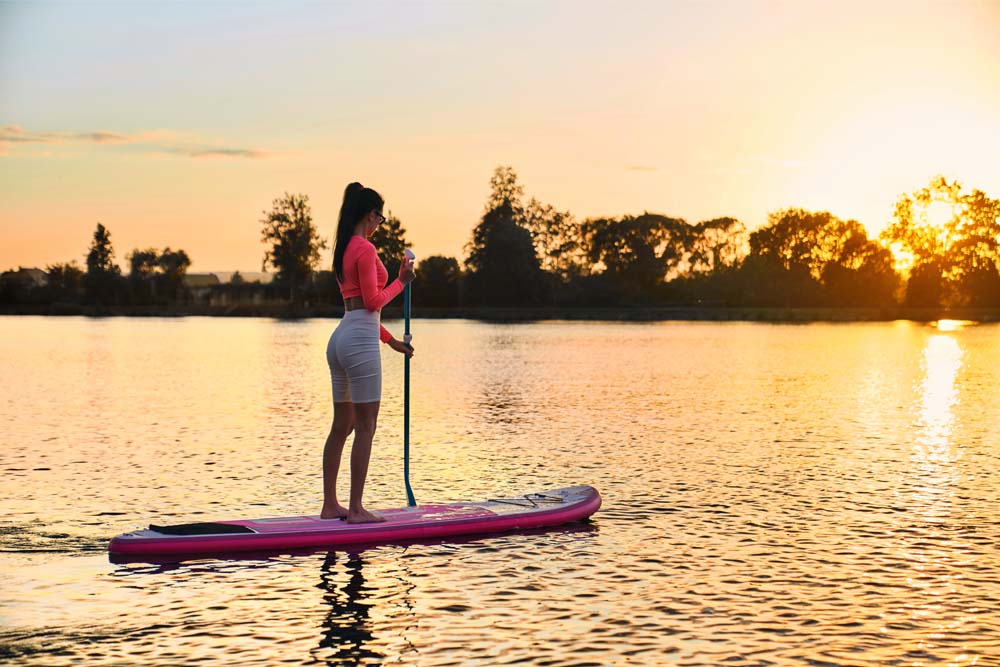
Now that you’ve got the basics down, it’s time to level up your paddle boarding skills.
These advanced tips will help you turn, maneuver, build endurance, and have even more fun on your paddle board. Let’s get into it!
Turning and Maneuvering Your Paddle Board
Turning your board efficiently is key to navigating through different water conditions and exploring new areas. Here are some advanced techniques:
- Pivot Turn: This is a quick way to change direction.
- Step back on the board to lift the nose out of the water.
- Use a sweep stroke to turn the board around quickly. This move is great for making sharp turns and maneuvering in tight spots.
- Cross Bow Stroke: For a more precise turn.
- Bring your paddle across the front of the board to the opposite side.
- Perform a forward stroke on that side to pivot the board. It’s a nifty trick for adjusting your direction smoothly.
- Side Stroke: To move sideways or adjust your position.
- Plant your paddle in the water perpendicular to the board and sweep the paddle away towards you, guiding the board forward.
- This helps you slide the board sideways, which is useful for docking or navigating around obstacles.
How to Build Endurance and Strength
Paddle boarding is not just about technique; it’s also about endurance and strength. Here’s how to build up both:
- Practice Paddling Long Distances: Gradually increase the distance you paddle. This builds stamina and gets your body used to longer sessions on the water.
- Core Workouts: Incorporate exercises like planks, sit-ups, and leg raises into your routine. A strong core helps you paddle more efficiently and maintain better balance.
- Cardio Training: Running, cycling, or swimming can improve your overall fitness and cardiovascular health, making longer paddling sessions easier.
- Interval Training: Alternate between fast paddling and a slower, relaxed pace. This can help build endurance and improve your overall paddling performance.
Fun Exercises to Practice on Your Paddle Board
Who said workouts can’t be fun? Here are some exercises to try on your paddle board that will improve your balance and strength:
- SUP Yoga: Try some basic yoga poses like downward dog, warrior, or child’s pose on your board. It’s a fantastic way to improve balance and flexibility.
- Squats and Lunges: These exercises strengthen your legs and improve stability. Start with shallow squats and work your way up to deeper ones.
- Paddle Sprints: Short, intense paddling bursts can boost your power and speed. Pick a landmark in the distance and paddle to it as fast as you can, then rest and repeat.
- Balancing Drills: Practice standing on one leg or moving from kneeling to standing positions. These drills enhance your balance and coordination.
By incorporating these advanced techniques and exercises into your routine, you’ll become a more skilled and confident paddle boarder.
Plus, you’ll have a blast doing it! Paddle boarding is all about having fun and challenging yourself, so keep experimenting and enjoy every moment on the water.
Next up, let’s talk about how to take care of your paddle board and gear to ensure they last for many adventures to come.
How You Can Take Care of Your Board : Essential Paddle Board Maintenance and Care Ritual
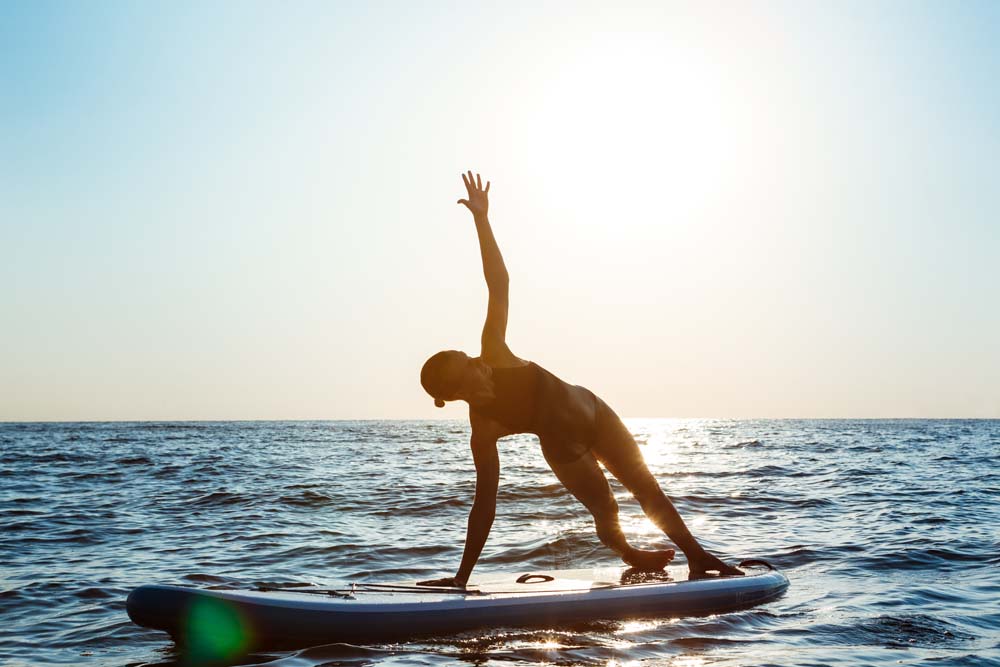
Taking good care of your paddle board and gear ensures they last longer and perform better.
Plus, it keeps you safe and ready for the next adventure. L
et’s go over some key maintenance tips to keep your equipment in top shape.
Cleaning and Storing Your Paddle Board
After a fun day on the water, it’s important to clean and store your board properly. Here’s how:
- Rinse with Fresh Water: Saltwater and lake debris can damage your board over time. Rinse it off with fresh water after each use, paying attention to the fin and leash areas.
- Mild Soap and Soft Brush: For a deeper clean, use a mild soap and a soft brush. This helps remove any stubborn grime or stains without scratching the board.
- Dry Thoroughly: Make sure your board is completely dry before storing it. Moisture can lead to mold and mildew, especially if you’re storing it in a damp area.
- Store Properly: Store your board in a cool, dry place, away from direct sunlight. UV rays can degrade the material over time. If possible, store it inside on a rack or hanging from the ceiling. For inflatable boards, deflate and roll them up carefully.
Tips for Maintaining Your Paddle and Other Gear
Your paddle and gear also need some TLC to stay in good condition:
- Rinse Your Paddle: Just like your board, rinse your paddle with fresh water after each use. This prevents salt and debris from causing damage.
- Check for Damage: Regularly inspect your paddle for cracks or chips. A damaged paddle can affect your performance and safety.
- Leash Care: Rinse and check your leash for wear and tear. Replace it if you notice any fraying or weak spots. The leash is crucial for your safety, so don’t neglect it.
- Personal Flotation Device (PFD): Rinse your PFD and let it dry completely before storing. Check the straps and buckles for any signs of wear.
When to Consider Upgrading Your Equipment
As you become more experienced, you might want to upgrade your equipment. Here are some signs it’s time for an upgrade:
- Skill Improvement: If you’re progressing and want to try new SUP activities like racing or SUP surfing, a more specialized board can enhance your experience.
- Wear and Tear: If your board or gear shows significant signs of wear and tear, it might be time to invest in new equipment. Cracks, leaks, and faded traction pads are good indicators. Here is a selcction of useful gears that are really interesting to make your trips even better with The Best Paddle Board Accessories.
- Comfort and Performance: If you find your current setup uncomfortable or feel it’s not performing as well as you’d like, consider upgrading. A more advanced paddle or a board with better features can make a big difference.
- Technology Advancements: Newer models often come with improved technology and materials that enhance performance and durability. Staying updated with the latest gear can enhance your paddle boarding experience.
Taking good care of your paddle board and gear ensures that they stay in great condition for many outings to come. Proper maintenance not only extends the life of your equipment but also keeps you safe and ready for any adventure.
Now that you know how to maintain your gear, let’s explore how to make the most of your paddle boarding experience!
Conclusion: Embrace the Paddle Boarding Journey
Congratulations! You’re now equipped with everything you need to dive into the world of paddle boarding.
From choosing your first paddle board to mastering your stroke and exploring new waters, you’ve got all the tools and tips to make your SUP adventures unforgettable.
Personally, paddle boarding has given me countless memorable moments.
I’ve watched breathtaking sunrises, encountered playful dolphins, and shared laughter-filled days with friends and family.
Each time I ride my board, it brings a new experience, a new story to tell.
And the best part?
There’s always something new to learn and explore.
Remember, it’s okay to wobble, fall, and get back up again. Every paddle boarder started as a beginner, and every expert had their share of spills.
The key is to enjoy the journey, savor each moment, and keep paddling forward.
Whether you’re paddling on a calm lake, navigating a winding river, or catching waves at the beach, each stroke takes you further into a world of adventure and fun.
So grab your paddle, step onto your board, and let the water guide you. Embrace the paddle boarding journey with confidence and excitement.
The water is waiting, and your adventure is just beginning.
References
Here are the references used for gathering information for this article:
- Outdoor Foundation. “Outdoor Participation Report 2020.” Outdoor Industry Association.
- SUP Board Guide. “How to Choose a Stand Up Paddle Board.” SUP Board Guide.
- REI Co-op. “Paddle Boarding for Beginners: Tips & Gear.” REI Co-op.
- Paddling Magazine. “Paddleboarding Basics: Getting Started with SUP.” Paddling Magazine.
- ISLE Surf & SUP. “SUP Safety Tips: Stand Up Paddle Board Safety Checklist.” ISLE Surf & SUP.


0 Comments